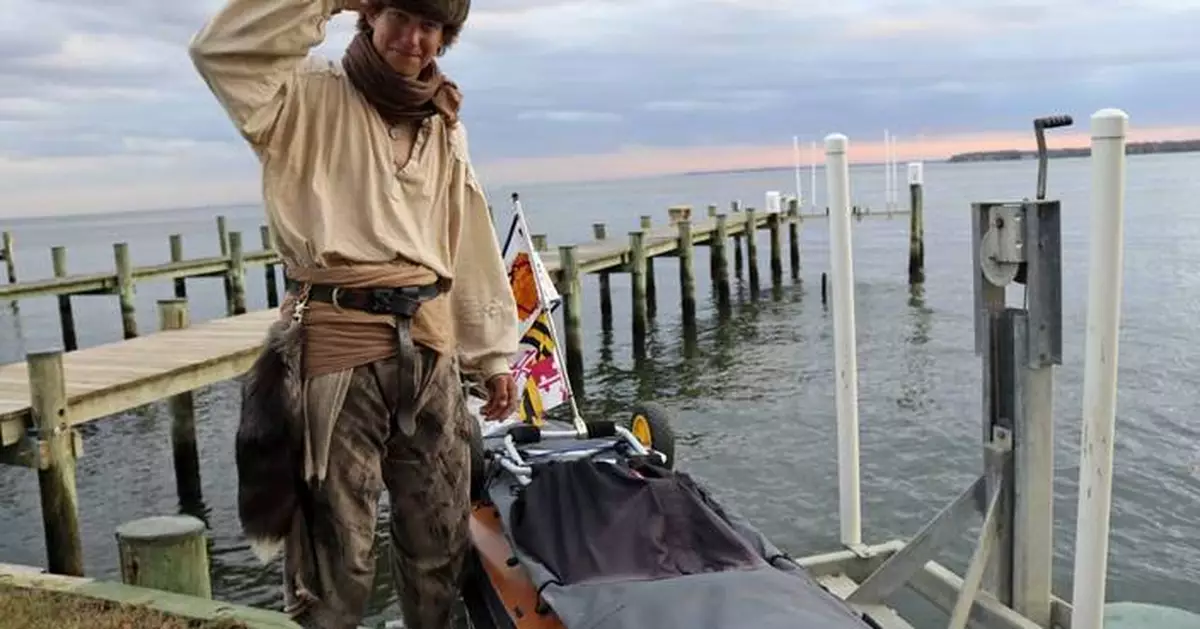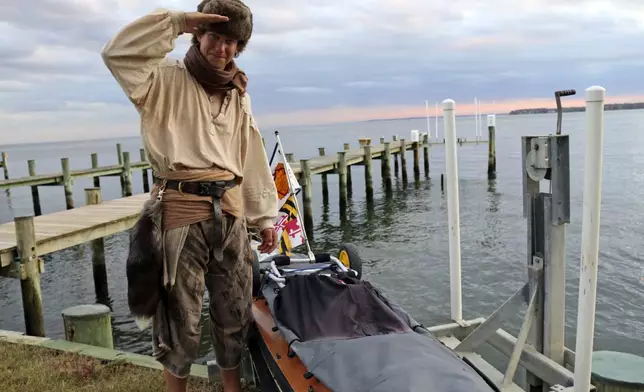ANNAPOLIS, Md. (AP) — Peter Frank has paddled from Michigan's Upper Peninsula in June to the Chesapeake Bay in Maryland this month in his 1982 Sawyer Loon decked canoe, but he’s still got a long way to go.
The 23-year-old is about a quarter of the way on his planned journey of roughly 6,000 miles (9,656 kilometers) to complete the Great Loop route. This continuous watercourse includes part of the Atlantic and Gulf intracoastal waterways, the Great Lakes, part of Canadian Heritage Canals and inland U.S. rivers.
Click to Gallery
Peter Frank looks out over waters near Chesapeake Bay as he talks about resuming his voyage along the Great Loop during a stop in Annapolis, Md., Nov. 7, 2024. (AP Photo/Brian Witte)
A detail of Peter Frank's canoe is shown Thursday, Nov. 7, 2024 in Annapolis, Md. (AP Photo/Brian Witte)
Peter Frank holds a map Thursday, Nov. 7, 2024, of the Great Loop, a 6,000-mile journey he is trying to complete in a canoe, during a stop in Annapolis, Md. (AP Photo/Brian Witte)
Peter Frank talks about his attempt to complete the roughly 6,000-mile Great Loop in a canoe during an interview with the Associated Press on Thursday, Nov. 7, 2024 in Riva, Md. (AP Photo/Brian Witte)
Peter Frank, who is attempting to make a roughly 6,000-mile trip in his canoe to complete the Great Loop, poses by his canoe Thursday, Nov. 7, 2024, in Annapolis, Md. (AP Photo/Brian Witte)
Peter Frank stands by his canoe in Annapolis, Md., on Thursday, Nov. 7, 2024, a day before he plans to resume his trip along the Great Loop in what is roughly a 6,000-mile voyage and that he estimates will take him a total of about 17 months. (AP Photo/Brian Witte)
For Frank, the voyage is largely a way to express his gratitude for still being alive and having the ability to take on the physical challenge, almost a decade after a car accident left him with 14 broken bones and nearly paralyzed. He had been hiding in a pile of leaves to surprise a friend when a carful of teens drove through the pile without knowing he was there.
“It’s my form of showing the appreciation for being alive and being able to walk and do the things that I can do," he says during a break in Annapolis, Maryland, earlier this month, a day before setting out again.
He also enjoys writing about his experiences on his blog and meeting people along the way.
“I’m grateful to be out here and to share this story,” Frank says. "In some regard, I feel that I have a responsibility to document the things that I experience for people who don’t get to experience them or that dream of experiencing them. That is why it’s important to me.”
Clad in a rabbit-fur hat and clothes he made himself to resemble a pirate, he generally paddles between six and 10 hours a day in his 1982 decked vessel, its shell hollowed to stow supplies. Many nights, he sleeps in a tent by the water. However, he often gets invitations from readers of his blog to stay in their homes.
To keep warm, he's picked up a 1970s vintage heavy down coat, an ultra-light Patagonia jacket he found in a thrift store, 1950s German military cold weather mittens, a set of warm thermals, and several wool socks. Recently, when he felt underdressed, he designed and sewed his own pants that he quilted over cotton flannel for extra layering.
He carries 10 portable power banks, plus cords and outlet plugs. He says his electronics bag alone, holding only batteries and cords, weighs almost 25 pounds (11 kilograms).
“I find that 10 is a good amount and will keep me charged on GPS, radio, cameras and phone battery through any predicament,” he says. “I also carry a solar panel as a backup and can charge almost anything I need.”
He doesn't carry much for self-defense: only a small filet knife for fish and a pocket knife for cutting rope. Frank says he's confident in his ability to protect himself, such as being mindful in bear country, tying up food, or simply avoiding populated areas.
“In the long run, it’s never been much of a concern, and anything beyond my control isn’t something I can prevent with anything I can take with me,” he says.
The Eagle Scout, who still visits with a local scout troop in his hometown, has prepared a hearty portion of his food for the long adventure. He dehydrated game meat and ground beef in an oven and vacuum-sealed it for the trek.
Frank earns some income by writing about his experience. His blog also helps him pay grocery bills via his “Rotisserie Chicken Fund," where people can click to send him money.
“Every now and then, somebody will send me $20 online, which helps out a lot for like food and stuff, but in the meantime, I also write for magazines, and the magazines will publish my work," he says.
Frank has made long-distance trips by bicycle, unicycle and canoes before. For example, he's already explored Florida by canoe, which took him about 11 months, ending in May 2023. That's a significant portion of what he's trying to do now. He knows he'll eventually tie his canoe to mangroves during one stretch to sleep.
“I really, really do enjoy them," Frank says of the adventures. "I enjoy being alive most of all, and so I guess for me these expeditions are not only my college and my education, but it’s also my form of worship in a way, my giving thanks to the world for being alive and being able to walk.”
The Great Loop is his most challenging trip yet. While the journey is a bucket-list route for avid boaters, it's rarely done with reliance on muscling a canoe.
Frank also travels clockwise, which he says is the harder route because he's paddling against the current on inland rivers for more than 25% of the trip.
Frank launched his trip on June 27 in Escanaba, Michigan, where he's from. He paddled into Canada and crossed Lake Ontario, where he camped on islands. On his way south, he went through New York City, floating by the Statue of Liberty.
While he's given some long study to the Great Loop route, not everything has been perfectly mapped out for the canoeist. He says he’s had to do some wayfinding on his own.
While leaving New York, he took the Delaware and Raritan Canal, using portages he says he found on his own that weren't mentioned in route plans he had seen previously. Frank says he hopes to write an informational guide to fill in some gaps about details of the route. He's also thinking about writing an autobiography.
“I’d like to put something together that’s purely educational that would be a guide, and then I’d like to put something together that’s kind of like the story of a young man finding himself in a world that he doesn’t fully understand yet," Frank says.
He was living with his parents before he started traveling when he left home to unicycle across the United States for charity when he was 19.
“I’ll sometimes go back and visit for a couple of months between expeditions, but for the last three years I’ve just been traveling full time,” he says.
Everything he owns is in his canoe.
He says he doesn't need much money to keep on flowing.
“Contrary to what most people think, it doesn’t cost a tremendous amount to travel, especially when you eliminate plane tickets, gas, assets and accommodations like hotels and restaurants,” he says.
He's never had a lot of money, and he's done previous expeditions with less than $1,000.
“Is this comfortable or practical? Absolutely not, but through the struggles of following my dreams with little to nothing, I’ve developed the capacity to enjoy less, and as a result, I live well with little,” he says.
He also describes the trip as a voyage in self-discovery.
“It’s very hard to picture where I will be three years from now, as I’m still young and growing, but I’m hoping that on this journey, this very long journey of self-discovery, I’ll perhaps find that," he says.
He estimates it will take roughly 17 months to finish the loop. He'll need to complete it by next November, he says, due to a natural deadline set by the freezing of the lakes he'll need to cross.
“I would say that nature is my biggest competitor, most definitely," Frank says.
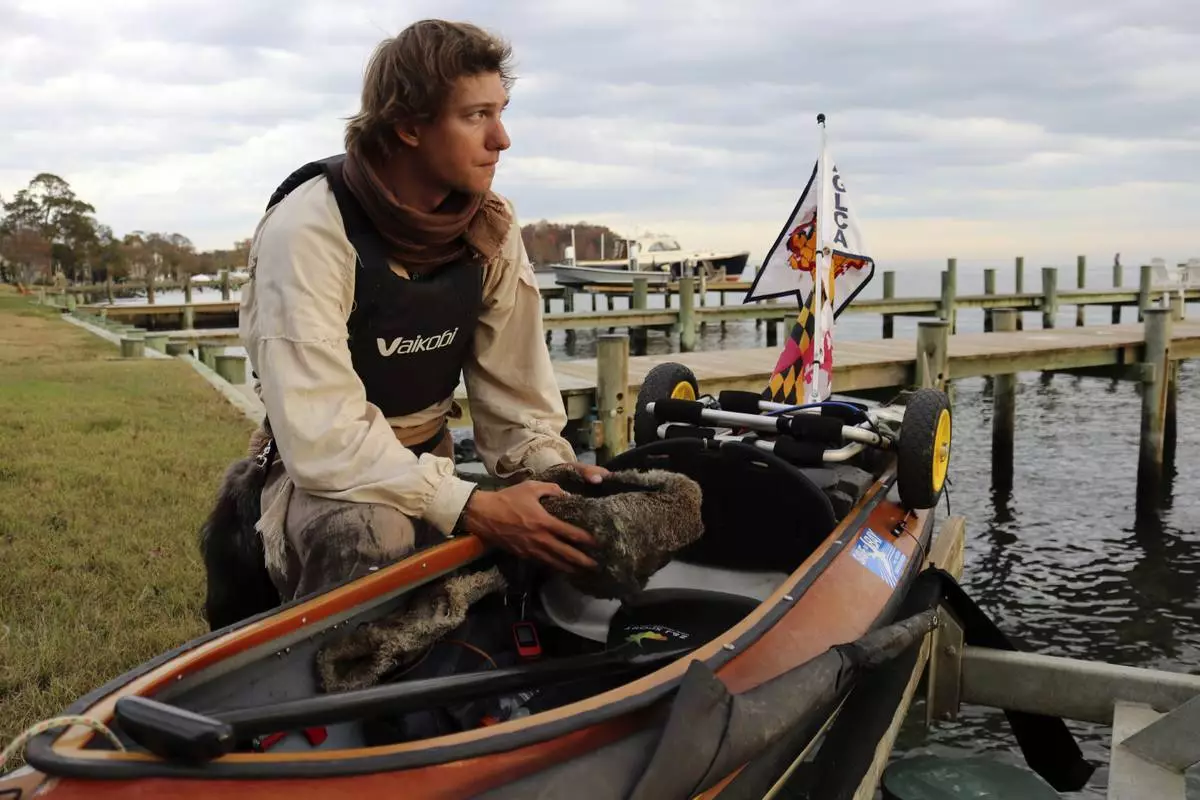
Peter Frank looks out over waters near Chesapeake Bay as he talks about resuming his voyage along the Great Loop during a stop in Annapolis, Md., Nov. 7, 2024. (AP Photo/Brian Witte)
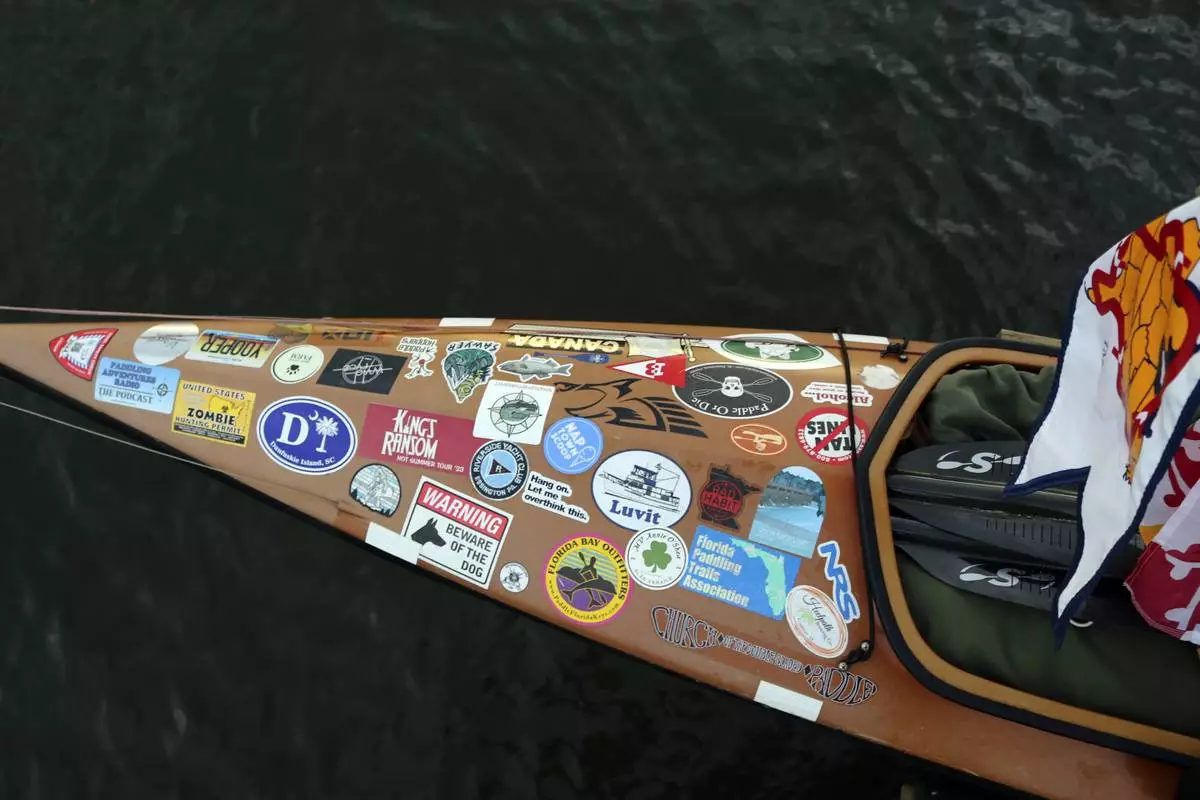
A detail of Peter Frank's canoe is shown Thursday, Nov. 7, 2024 in Annapolis, Md. (AP Photo/Brian Witte)
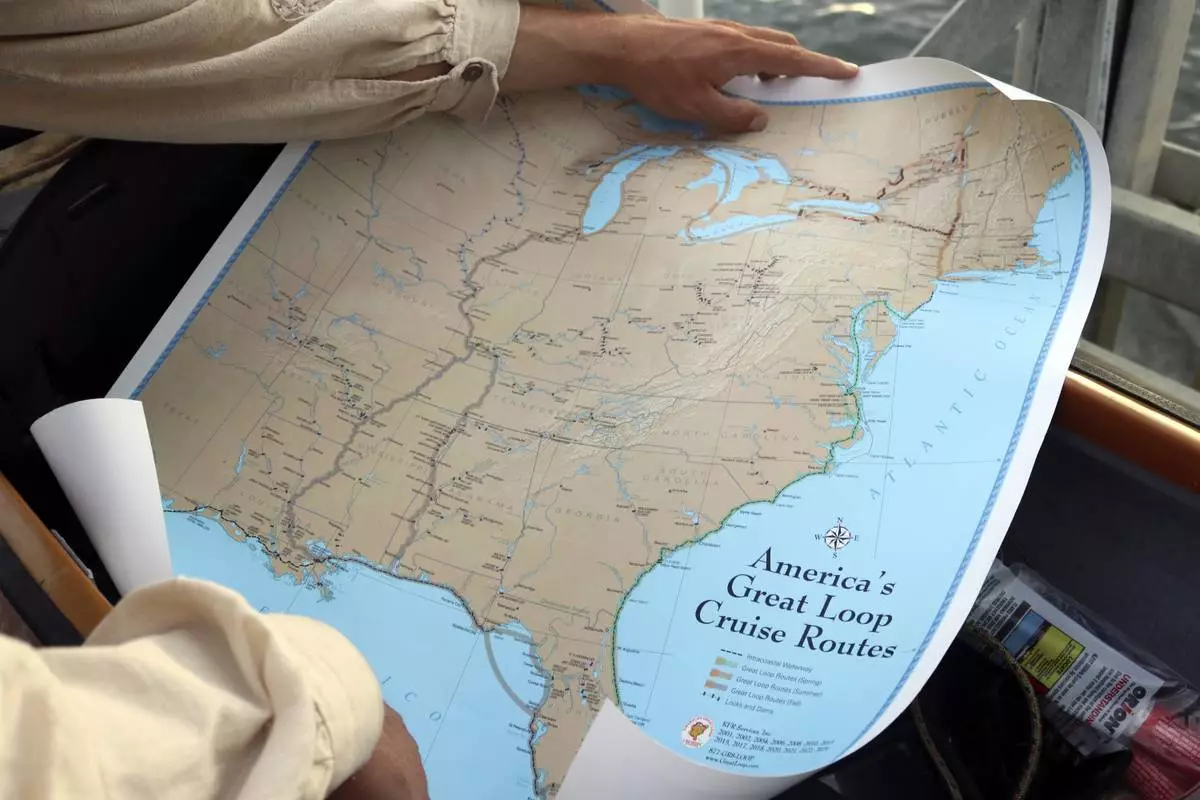
Peter Frank holds a map Thursday, Nov. 7, 2024, of the Great Loop, a 6,000-mile journey he is trying to complete in a canoe, during a stop in Annapolis, Md. (AP Photo/Brian Witte)

Peter Frank talks about his attempt to complete the roughly 6,000-mile Great Loop in a canoe during an interview with the Associated Press on Thursday, Nov. 7, 2024 in Riva, Md. (AP Photo/Brian Witte)
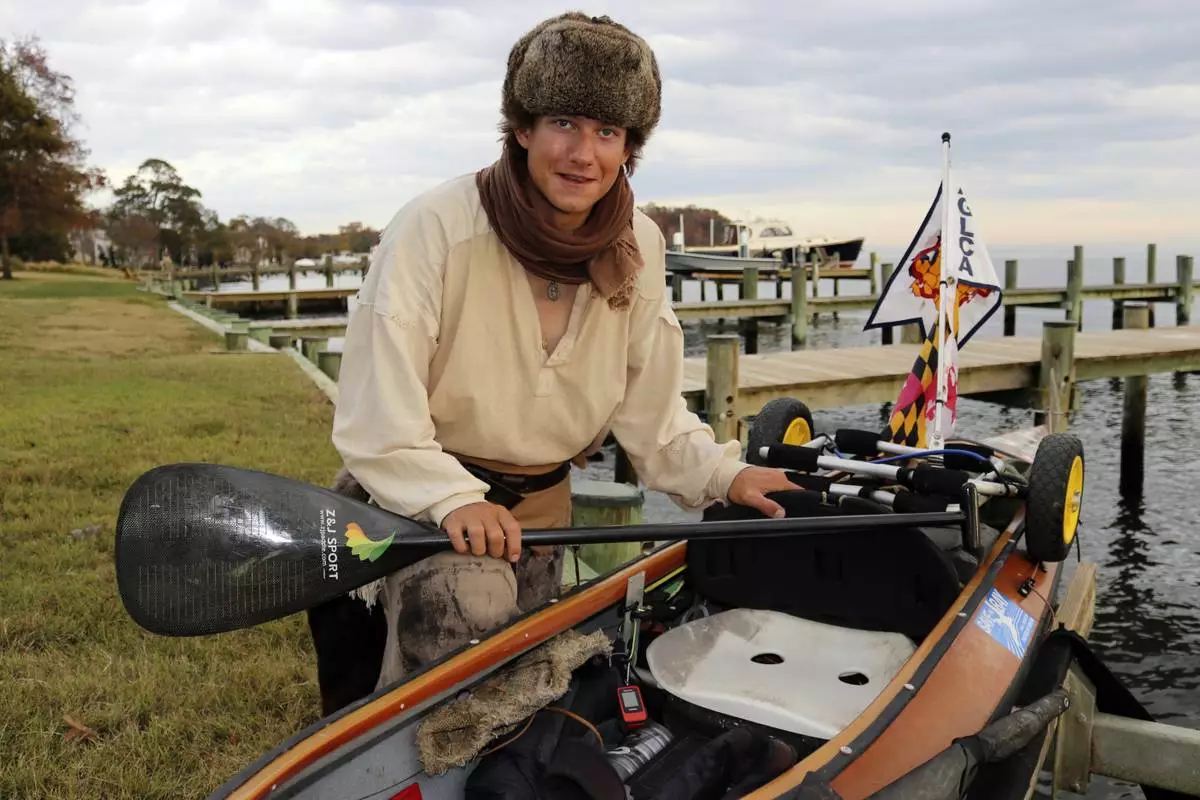
Peter Frank, who is attempting to make a roughly 6,000-mile trip in his canoe to complete the Great Loop, poses by his canoe Thursday, Nov. 7, 2024, in Annapolis, Md. (AP Photo/Brian Witte)

Peter Frank stands by his canoe in Annapolis, Md., on Thursday, Nov. 7, 2024, a day before he plans to resume his trip along the Great Loop in what is roughly a 6,000-mile voyage and that he estimates will take him a total of about 17 months. (AP Photo/Brian Witte)
WASHINGTON (AP) — Voters in central Mississippi and the state’s Delta and Gulf Coast areas will return to the polls Tuesday to resolve two judicial races in which no candidate received the vote majority needed in the Nov. 5 general election to avoid a runoff.
At stake are seats on Mississippi’s two highest courts, the state Supreme Court and the state Court of Appeals. Judges on both panels serve eight-year terms, the longest of any elected office in the state.
In the state Supreme Court race, Justice Jim Kitchens seeks a third term in District 1, also known as the Central District, which spans the state’s midsection from the Alabama border to the Delta region along the Mississippi River. Kitchens is the more senior of the Court’s two presiding justices, putting him next in line to serve as chief justice. He faces a challenge from Jenifer Branning, a Republican state senator in her third term. Branning was the top vote-getter in the general election, with 42% of the vote to 36% for Kitchens, with the rest split among three other candidates.
The courts are officially nonpartisan, but partisan fault lines have formed nonetheless in the Supreme Court race, with Democratic areas in the competitive district largely supporting Kitchens in the Nov. 5 election and Republican ones backing Branning. This was similar to the voting pattern in Kitchens’ 2016 reelection bid, when he won the support of the state's Democratic areas and his opponent mainly drew support from Republican areas.
Branning has branded herself a “constitutional conservative” and rails against “liberal, activists judges” and “the radical left.” She has the endorsement of the state Republican Party.
Kitchens has issued dissents in high-profile death row appeals, including a September case in which he sided with a man on death row for a murder conviction where a key witness had since recanted her testimony. In 2018, he dissented in a pair of death row cases dealing with the use of the drug midazolam in state executions. Kitchens has the endorsement of the Southern Poverty Law Center’s Action Fund, a civil rights organization.
Branning has had a sizable financial advantage over the incumbent since launching her campaign in February, thanks largely to a $250,000 personal loan she made to her campaign.
In the Court of Appeals race, Amy St. Pe’ and Jennifer Schloegel were the top two finishers in a competitive three-way contest on Nov. 5 to replace outgoing Judge Joel Smith. St. Pe’ placed first in the general election with 35% of the vote, followed by Schloegel with 33%. The Court’s 5th District is on the Gulf Coast in the southeastern corner of the state.
Here’s a look at what to expect on Tuesday:
Mississippi’s general election runoff will be held Tuesday. Polls close at 8 p.m. ET.
The Associated Press will provide vote results and declare winners in runoff elections for seats on the state Supreme Court and state Appeals Court.
Any voter in Supreme Court District 1 or Appeals Court District 5 who registered for the Nov. 5 general election may participate in the general election runoff.
Although Mississippi is reliably Republican in statewide elections, the Supreme Court’s Central District is home to much of the state’s Democratic strongholds, including the Jackson area and the counties in the Mississippi Delta region. Democrats Hillary Clinton and Joe Biden both carried the Central District in their 2016 and 2020 presidential campaigns, while Kamala Harris trailed Donald Trump by less than a percentage point in 2024.
In the general election, Branning led in 10 of the 11 counties Trump carried, while Kitchens carried 10 of the 11 counties that Harris, Biden and Clinton all won in their campaigns.
The 11 Trump counties made up about 62% of the total general election vote, compared to about 38% for the 11 Harris counties. In order to win, Kitchens would need to build on his leads in the counties he carried Nov. 5 and peel off enough of the votes cast for the three other candidates in areas that Trump won. That was his path to victory in his 2016 reelection race, when he carried the same 10 Harris/Biden/Clinton counties, as well as his home county of Copiah and six other counties.
The most populous of these Kitchens-Trump counties is Madison, which made up about 13% of the total district vote earlier this month. Kitchens carried Madison in 2016 with 50% of the vote but only received 36% this year, compared to 47% for Branning. Trump carried Madison three times, most recently with 57% of the vote. Kitchens also carried neighboring Leake and Scott counties in 2016, but Branning had outright vote majorities there on Nov. 5.
Warren County on the Mississippi River will be another key battleground in the race. Trump carried the county by close margins in 2016 and 2024 and lost by a close margin in 2020. Kitchens received 55% of the vote there in 2016, but Branning had a plurality there on election night.
The Court of Appeals race takes place in a district Trump carried three times with roughly 70% of the vote. The most populous areas to watch are the neighboring counties of Harrison (home of Biloxi and Gulfport) and Jackson (home of Pascagoula), both on the Gulf Coast.
The AP does not make projections and will declare a winner only when it’s determined there is no scenario that would allow the trailing candidates to close the gap. If a race has not been called, the AP will continue to cover any newsworthy developments, such as candidate concessions or declarations of victory. In doing so, the AP will make clear that it has not yet declared a winner and explain why.
According to a September tally by the Mississippi Secretary of State’s office, there were about 609,000 active voters in Supreme Court District 1 and about 449,000 active voters in Court of Appeals District 5. Voters in Mississippi do not register by party.
The last time a state Supreme Court race advanced to a runoff was in 2016. About 339,000 votes were cast for that seat in the general election, but the total fell sharply to about 38,000 votes for the runoff held later that month.
In the Nov. 5 general election, turnout was about 54% of registered voters in the presidential race, about 48% in the state Supreme Court race and about 50% in the Court of Appeals race.
About 18% of votes were cast before Election Day in the 2020 general election and about 7% in the 2022 midterm elections.
As of Wednesday, a total of 4,021 ballots had been cast before the runoff election.
In the Nov. 5 general election, the AP first reported results at 8:19 p.m. ET, or 19 minutes after polls closed. The election night tabulation ended at 2:35 a.m. ET with about 93% of total votes counted.
Read more about how U.S. elections work at Explaining Election 2024, a series from The Associated Press aimed at helping make sense of the American democracy. The AP receives support from several private foundations to enhance its explanatory coverage of elections and democracy. See more about AP’s democracy initiative here. The AP is solely responsible for all content.
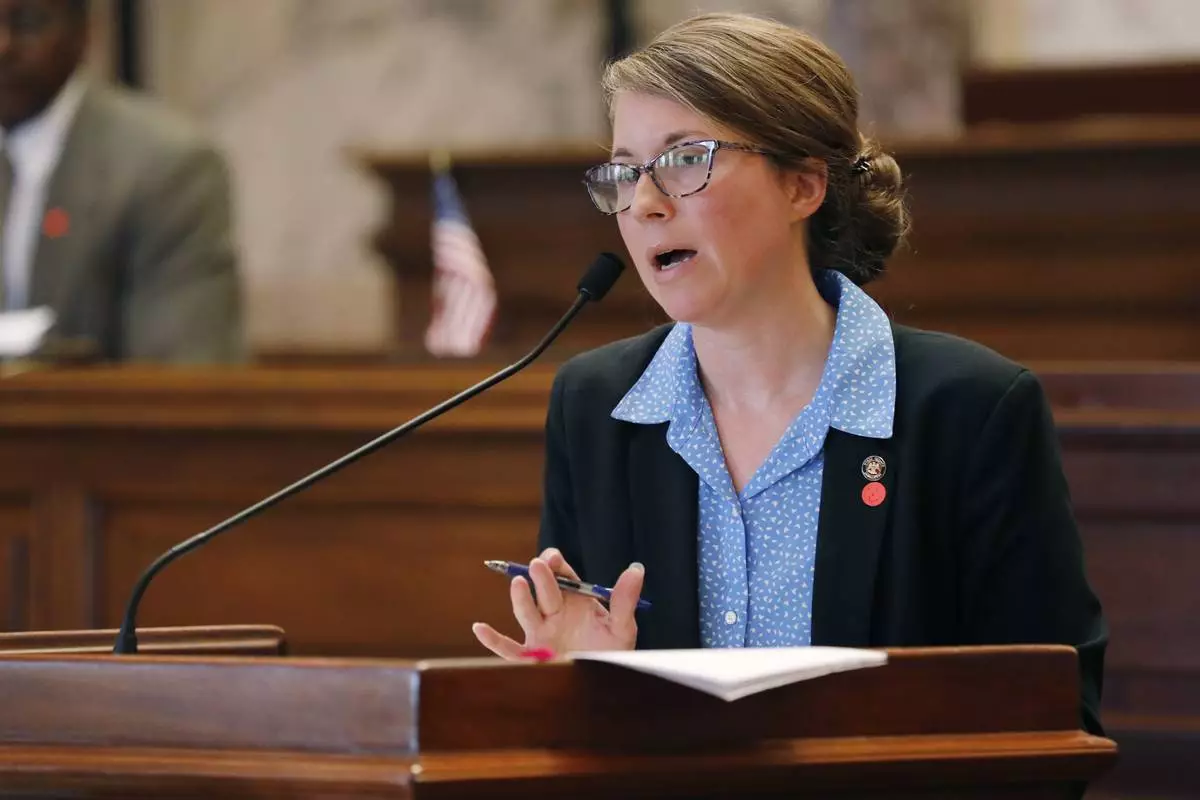
FILE - Senate Elections Committee Chair Jenifer Branning, R-Philadelphia, explains a facet of an absentee-ballot bill during floor debate at the Capitol in Jackson, Miss., June 15, 2020. (AP Photo/Rogelio V. Solis, File)
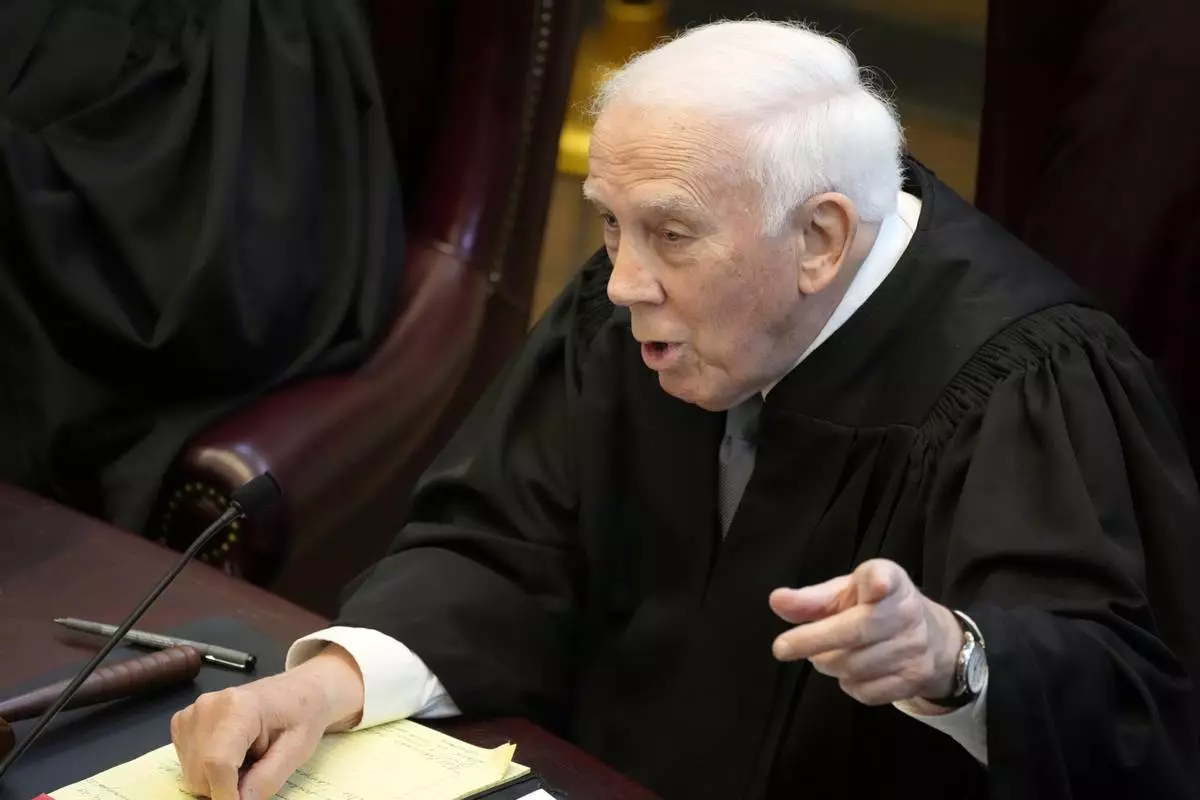
FILE - Mississippi Supreme Court Presiding Justice James W. Kitchens asks a question, July 6, 2023, before the court in Jackson, Miss. (AP Photo/Rogelio V. Solis, File)
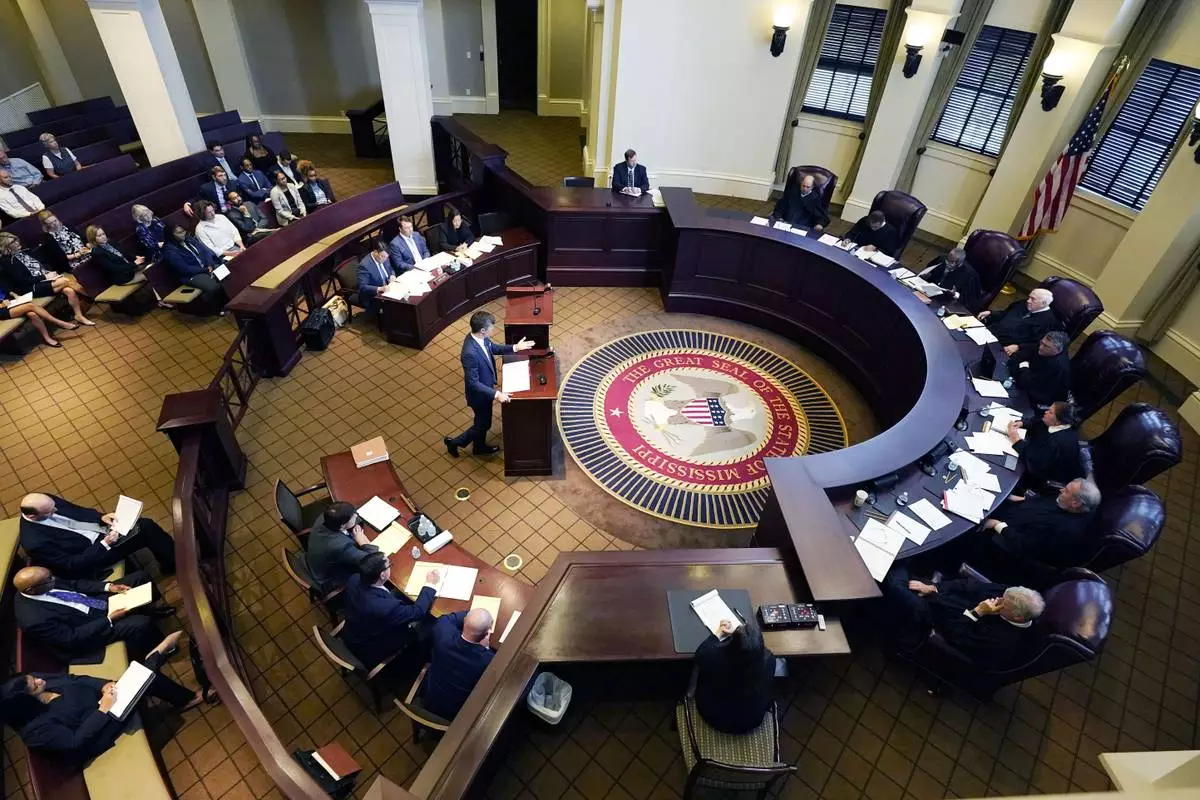
FILE - Mississippi Supreme Court justices including Justice Jim Kitchens, seated at right, fourth from top, listen to arguments, July 6, 2023, in Jackson, Miss. (AP Photo/Rogelio V. Solis, File)








